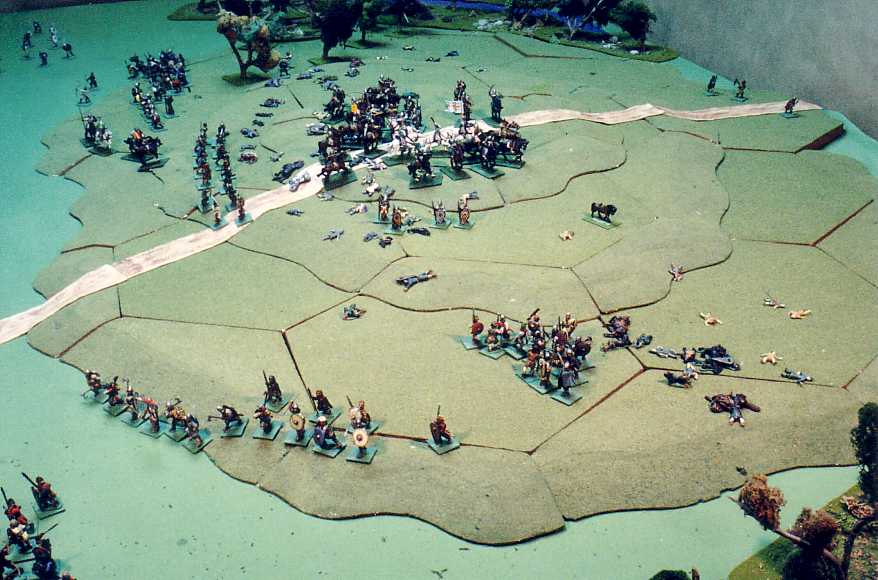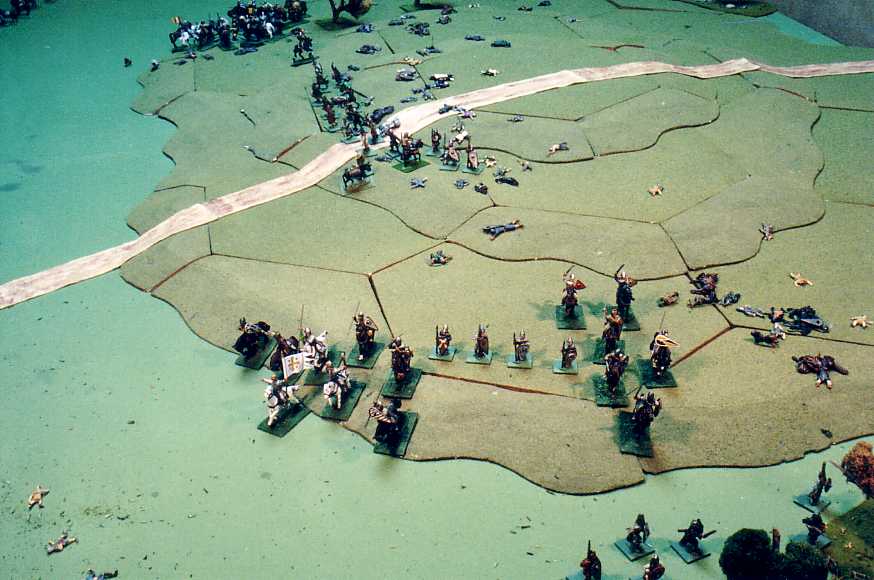Turn by turn development of the battle of Hastings
using the wargame rules The Art of War

Bretons counterattack
But the Breton knights are not through yet and attack uphill into the advancing English-right. The English-left reaches the French marksmen in the rear and attacks them (extreme lower-left of picture). The housecarles and fyrd of the English-center are mown down.

Breton counterstroke
Worsted again, the last 200 Breton knights still ahorse withdraw and ride around the left flank of the English-right. The English-left continues to advance downhill, completing the destruction of the French-right. The last few pockets of English resistance in the center are wiped out.

William holds the field
The Breton knights charge downhill into the housecarles of the English-right: Leofwin is slain here. Duke William reforms his cavalry on top of Senlac hill.

Duke William sets out in pursuit of Gyrth Godwinson
As the duke rides downhill toward the withdrawing English-left, he also sends cavalry reinforcements toward the Breton-left. Count Eustace (the commander of the now-defunct French-right) makes an attack with not more than 150 mounted troops into Gyrth's unit - and withdraws shortly after almost alone. (This shows Eustace - on the white horse in the bottom of the picture - with the last "50" of his command left to him.)

The final moments
The English-right forms square around Leofwin's body and awaits the onslaught of the Breton and Norman knights. Duke William pursues the English-left to the trees (off to the bottom of the picture), but cannot stop them from escaping the stricken field: as Gyrth Godwinson is still very much alive, this battle ends up a draw: duke William will still face strong English opposition in the weeks ahead.

Closeup of the last fighting on the Breton-left
The square has been broken and ridden down. The last few score of English warriors are pursued out over the marshy ground of the Asten brook.
The Art of War - a brief destription of how the rules work
The Art of War is an individual combat system. That is to say, each combat pairing is rolled for separately on the Combat Results Table. This method allows the battle to possess the one-on-one (or "skirmish") feel we want, but nicely simulates large-scale massed combat: the missile fire is rolled in "batches" (or volleys). Once combat is joined, the war-gamer has little control over events; his nicely formed lines come to pieces, lying vulnerable to counterattack. As the preceeding picture narrative shows, the more cohesion a line can retain the more likely it is to be victorious.
The individual combat resolutions go quickly, because the modifiers are basic to positioning of the attacker (either from the front, flank or rear) and terrain bonuses (e.g. +25% to combat value for infantry defending uphill on a "class one" slope - and there are only zero to three classes of slope: similarly, only zero to three densities of woods: so the modifiers to combat are few and easily remembered). The bases advance into gaps made by pushing back or eliminating an enemy base: some of these pushed-back bases can rout. In short, the fights get very "pretty" as they get messy; and you have no control over any of this: it just happens.
A neat thing we reflect with this pushing and shoving result, is how a line being penetrated allows defending bases in back ranks to envelope a penetrating base on its flanks: equally, a penetrating base can turn as it enters the hole and attack a defender in flank. In situations like these the single base being attacked by two or more enemy bases loses half its combat value for being attacked in flank (zero combat value if attacked in rear), and the bases ganging up on the single enemy base add their combat values together for a single combat results roll.
The combat results allow for individual bases turning away in rout: and these bases might recover: so while this is a possibility we leave them on the table: but if and when the routed cannot rally, we remove them as permanent casualties.
So the combat is simple, yet it produces confusing looking battles that are in reality very easy to resolve: you just start at one end with the first combat pairing and roll for each combat pairing all down the line, pushing and falling back, removing casualties and turning around routing bases.
The pictures are of an actual solo game (or I should say two solo games) that I played out a number of years ago. The only thing I "fudged" for appearances is having 75% of the casualties running off in rout mode, and laying down 25% of them as dead.
When I play The Art of War with friends (I never play with enemies) I seldom lay down any dead figures; and instead we remove from the table all casualties: because it would be useless (and confusing) to have the c. 75% routed of each eliminated base running around: it is assumed that they are there, but they are so thoroughly disorganized that they are no longer under command control - having scattered into individuals or very small groups; so their physical presence on the battlefield is not felt beyond lurking and looting.
All of the moving (in a real multi-player game, where everyone's time is limited) is done by putting the individual bases together on a movement tray (or on several trays). But when combat is joined, the trays are removed. When I solo (as here), time not being a factor, I casually (lovingly) move each individual figure, and dispense with the ugly movement trays.
Movement is by whole units or "divisions" (battles): a "walk" move is 4" per turn and is the standard speed by which irregular infantry advances in close formation. (Virtually all infantry in medieval Europe is of the "irregular" kind: even the city militias were not deeply enough drilled to manage an advance at the double - "trot" - or a close order charge: some few exceptions do exist, e.g. the later Scots can charge when in a column.) Cavalry are more regularly trained, and William's army at Hastings possessed the cream of feudal chivalry: they can advance in dense formations at any speed a horse can make: good drill kept the fastest horses down with the slower until the last moment of the charge before contact. But, in fact, at Hastings the cavalry seldom (if at all) get the opportunity to charge: battle Hill is too rough and steep. A "trot" move for cavalry is 8" per turn: this is the maximum speed the invaders' cavalry can make going up Senlac hill. (Charge speed for heavy cavalry in the game is 14" per turn.) Light infantry can run 10" per turn: this should give you a general idea of how far the units are moving in the pictures that are back-to-front turns. As for scales: the ground distance scale in The Art of War is 1" = c. 10 yards; each turn is c. 30 seconds of real time. The number of real men/horses per base is 64 infantry and 50 cavalry (on the size of bases used in my armies: 20mm by 20mm for infantry; 25mm by 50mm for cavalry).
Morale is equally simple: we never worry about the plethora of "important" factors common to most rules. The only things deemed historically accurate and pertinent to all morale states are: casualties suffered by the unit; whether or not the unit can see friendly units routing; and some tactical factors, such as checking to receive charging cavalry, or cavalry repulsed by a phalanx. The morale test is a simple 2d6 roll, needing a number or higher for morale to remain "good". Failed morale results in a unit turning their keisters toward the enemy and running away. To rally a routed unit (or individual base/s) requires that they not be pursued - shot at - and they must make a successful morale test (needing the same number or higher on 2d6).
Are you interested in purchasing The Art of War war-game rules? You can buy them as an Ebook (.mobi, for Kindle) by clicking HERE.
NEXT: refight number nineteen
HOME





